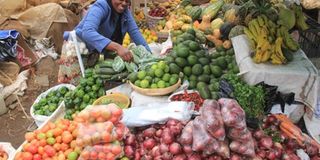Africa makes strides in food security but hurdles remain

Fresh produce at a market in Nyeri County. Food production in sub-Saharan Africa has been on the rise in the last 10 years, but it still lags behind Asian and Latin American countries. PHOTO | JOSEPH KANYI | FILE
What you need to know:
- Better seeds, fertilisers and new farming methods have seen output jump in the past decade but millions still lack food
Food production in sub-Saharan Africa has been on the rise in the last 10 years, but it still lags behind Asian and Latin American countries.
Use of high-yielding seeds, access to fertilisers and modern farming practices have seen Africa’s crop output jump significantly in parts of the continent that for decades had been food-insecure, studies conducted since 2005 show.
“Cereal grain yields increased by 50 per cent between 2005 and 2013, still a miserable 1.5 tonnes per hectare, but the trend is up for the first time since records began,” stated Dr Pedro Sanchez in a report published in Nature Plants, an globally acclaimed scientific journal.
Dr Sanchez, who is also the director of the Agriculture and Food Security Centre at Columbia University, cites the creation of the Alliance for a Green Revolution in Africa and the Millennium Villages Project as crucial to the positive results.
“More recently, the private sector joined the effort, marking the beginning of a private sector-led, government-enabled African green revolution,” he noted.
However, even as African farmers record bountiful harvests, the production is far from the volumes attained by Asian and Latin American countries that attain three tonnes of harvest per hectare. Comparatively, Africa is even further from matching North America, Europe and Japan whose farmers harvest 10 tonnes of grain per hectare.
Kenya is a long way from attaining Millennium Development Goal one, which requires countries to eradicate extreme hunger and poverty.
Government statistics show that 54 per cent of farmers in rural areas are net buyers of food. This means they are not only unable to produce enough food for sale, but they are also incapable of feeding themselves.
Food assistance
According to the World Food Programme, 1.5 million Kenyans will be in need of food assistance through early 2015, a 15 per cent increase from last year.
“The problem is that Kenya has a poor track record of food security. Before the Jubilee government (came in), Kenya had no way of measuring holistic food security,” said Dr James Nyoro, the senior food security and climate change adviser to the President.
He said the secret to food security is increasing production. “The government has initiated several programmes to ensure that farmers produce more food from their parcels of land. They include fertiliser subsidies where they now pay Sh2,000 for a bag of DAP fertiliser as opposed to Sh4,000,” he said.
Other interventions are farm mechanisation such as use of tractors to till large tracts of land.
But what is expected to be a game-changer in the country is the Galana/Kulalu irrigation project which seeks to put one million acres under food production.
Dr Nyoro said the project is expected to generate more than 70 million bags of maize per year through irrigation.
The country currently produces 40 million bags. “The pilot project of 10,000 acres will be complete by June, this year. From that, we will be able to upscale the project to use the entire one million acres,” noted Mr Nyoro.
In the Galana project, 500,000 acres will be under maize, 200,000 acres under sugarcane, 50,000 acres under fruits while horticulture will take 50,000 acres. Another 150,000 acres will be set aside for ranching and a game reserve. Dairy farming takes 50,000 acres.




